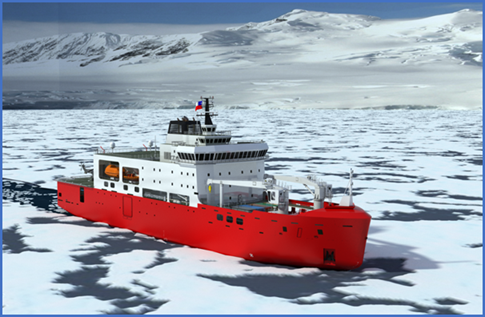



our
credentials
Ibercisa has designed, manufactured and is supplying the equipment for a series of avant-garde oceanographic vessels.
At the Armón Shipyard the new Swedish Institute oceanographic vessel, Swedish University of Agricultura Sciences (SLU), 69.50m length and 15,80 m width. It is designed by Skipsteknisk AS and the core activity of the vessels will be the study of ecosystems with particular emphasis on the assessment of fish stocks and monitoring of water quality. In addition, the vessel will be used for: data collection for studies and understanding of climate change effects; mapping of marine biodiversity: mapping of eutrophication; measurements of CO2 and the resulting acidification of the oceans; and measurements of oxygen and de-oxygenation of the oceans. The vessel will be delivered in May 2019.
For this vessel, Ibercisa has designed and supplied two electric winches for retracting keel, driven by am 18,5 kw motor at 1450 rpm with a capacity of 70 metres of cable of Ø12 mm and nominal line pull capacity of 4,2 tons at 24,4 m/min on the first layer. This vessel will also be equipped with one anchor windlass; two roller stoppers; 2 AFT mooring winches; two trawl winches; one net drum; one auxiliary winch; two trawl door winches; one net sounder winch; one CDT winch; one hydrographic winch; one SLU MIK trawl winch; SMHI multipurpose winch; one fish towing winch, and a moveable deck winch.
For project NB719 at the Spanish Freire Shipyards (Construcciones Navales P. Freire) and to be installed on board a Multipurpose Research Vessel in the Persian Gulf, commissioned by the Kuwait Institute for Scientific Research (KISR), Ibercisa Deck Machinery has designed and built two split trawl winches, one hydraulic net drum, one oceanographic winch (CTD), two hydraulic oceanographic winches, one oceanographic winch, one hydraulic codend winch, one anchor windlass, two roller stoppers and two hydraulic capstans.
Freire Shipyard has built the oceanographic vessel "Taqnia Damman", 43 m in length, for Saudi Technology Development and Investment Company (TAQNIA). This vessel includes a an oceanographic winch, one corer winch, two vertical anchor windlasses, two roller stoppers, three hydraulic capstands, two trawl winches and one net drum.
Ibercisa's success in this sector has meant that ASMAR, Astilleros y Maestranzas the Chilean naval shipyard, has signed an agreement with the Company for the supply of deck machinery for the Antartica-1 project, a modern oceanographic icebreaker of 111m length and 21m width.
The boat will operate at 3 knots on 20 cm of snow-covered ice of up to 1 m thick. With a crew capacity of 12, the vessel will have a cargo space of 510.m3 in the hold: 400 m3 for fuel storage and a further 400 m3 for pallet stowage. Required to operate at -30 ºC, the vessel was designed by the Navy Department of Investigation and Development programes, in conjunction with the Department of Naval Construction Projects at ASMAR with contributions from the Chilean Antarctic Institute, the Army, Air Force and Chilean Navy.
The new state of the art polar vessel will be operative from 2024. Ibercisa Deck Machinery will design, manufacture and supply the complete package of deck machinery which apart from oceanographic winches and hydrographics will also include LARS, gantrys and davits. The new icebreaker will have modern hydro-acoustics such as echo sounders, sonars, a bottom profiler, high precision currents and position acoustic profiler. It will also be equipped with microbiological and chemical laboratories as well as means for the collection, storage and conservation of samples taken from the seabed.
The boat will boast the highest crew safety standards recently set out in the "Polar Code" which regulates the fixtures and fittings for vessels navigating in arctic and antarctic waters as well as the environmental regulations, water treatment, gas and residue emissions, to comply with the Madrid Protocol for the Antarctic Treaty. It will also comply with the standards required by the Convention for the Conservation of Living Marine Resources in the Antarctic and will be overseen by skilled fishing inspectors for vessels operating in waters regulated by the Convention.
With this modern unit, Chile will lead countries in the southern hemisphere in terms of equipment and infrastructure for the conservation of the marine environment.
Freire Shipyad is also building the “NewRV” for Belgian scientific institutes. It will be a multidisciplinary oceanographic research vessel, offering room for more researchers and spending more time at sea on an annual basis (around 300 days per year). It will be built according to the strictest standards regarding energy use, emissions (green ship) and sound production (acoustically silent ship), and will be equipped with state-of-the-art acoustic underwater sensors that allow analysis of the water column (fauna included) as well as the bottom and substrate. The ship will also serve as a platform for European collaboration, and will be adapted to the existing modern European Marine Research Infrastructure (also opening up research opportunities for Belgian researchers, such as research that requires the use of Remotely Operated Vehicles, Autonomous Underwater Vehicles, etc.). It will be delivered in 2020 and its dimensions are 65 m. length and 15 m. beam.
The oceanographic shipping sector requires our complete attention and the technical department at Ibercisa Deck Machinery is totally dedicated to the development of equipment which is less noisy and more respectful of the environment.
press@ibercisa.es

